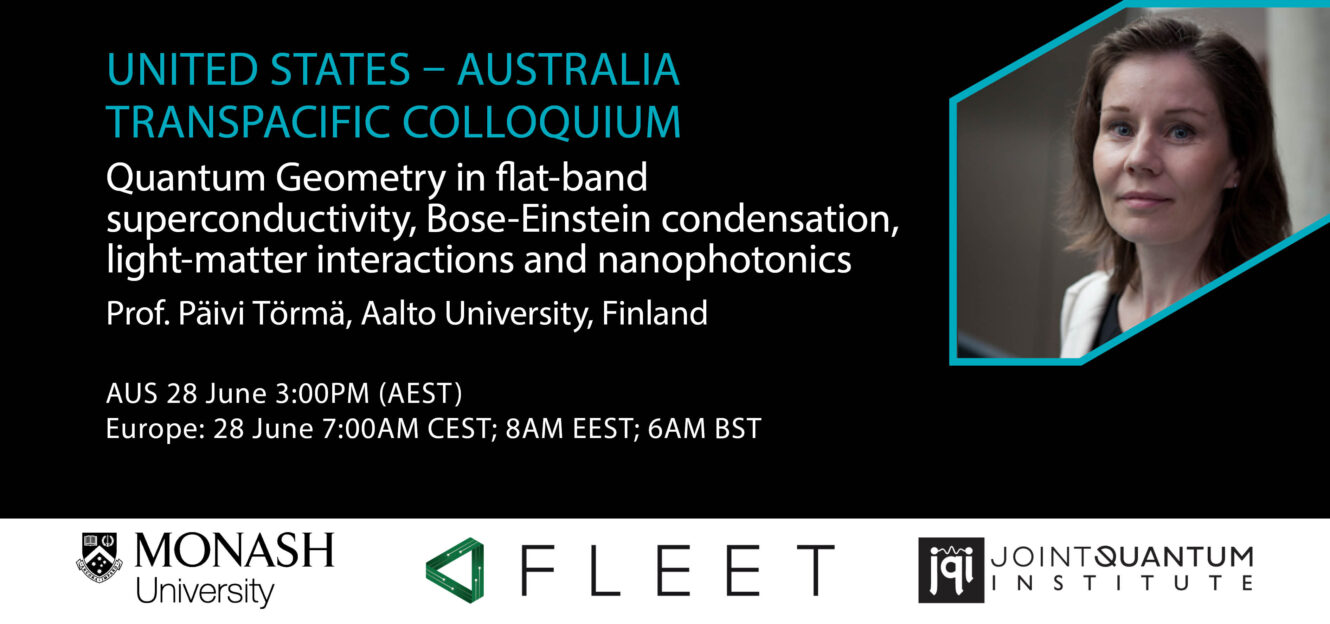-
28 Jun 2023
3:00 pm - 4:00 pm
Päivi Törmä, Department of Applied Physics, Aalto University, Finland
We have found that superconductivity and superfluidity have a connection to quantum geometry [1,2]. Namely, the superfluid weight in a multiband system has a previously unnoticed component which we call the geometric contribution. It is proportional to the minimal quantum metric of the band. Quantum metric is connected to the Berry curvature, and this allows us to relate superconductivity with the topological properties of the band. Using this theory, we have shown that superconductivity is possible also in a flat band where individual electrons would not move. Recently, we and other groups have shown [3,4] that these results may be essential to explain the observation of superconductivity in twisted bilayer graphene and may eventually help realize superconductors at elevated temperatures. In addition to the promise of high critical temperatures and strong correlation effects, also the quantum transport in flat band shows unique behavior [5]. In the normal state above the superconducting critical temperature, a new type of insulator can be found [6]. We have also explored the effect of quantum geometry on Bose-Einstein Condensation (BEC) and shown that the quantum distance and quantum metric determine the stability of the condensate, and quantum fluctuations dominate over mean-field effects [7]. Light-matter interactions become strongly enhanced by quantum geometry in flat bands [8].
Arrays of plasmonic nanoparticles (plasmonic lattices), when combined with an emitter material (gain medium), provide a versatile platform for studies on light-matter interaction in the nanoscale, including collective coherent phenomena as well as topological photonics. We have experimentally realized a new type of condensate: a BEC of hybrids of surface plasmons and light in a nanoparticle array, with unique polarization and coherence properties [9-12]. In the lasing regime, we have observed bound state in continuum (BIC) modes with different topological charges [13,14]. Recently, we studied the quantum geometric tensor in these systems. We experimentally observed non-zero quantum metric and Berry curvature along the diagonals of the Brillouin zone of a square lattice of gold nanoparticles [15]. By a theoretical analysis, we show that the Berry curvature originates solely from non-Hermitian effects [16].
Prof. Päivi Törmä is an Academy Professor at the Department of Applied Physics and leads the Quantum Dynamics (QD) research group. Her research interests are in the area of many-body quantum physics, ultracold gases, nanoscience and nanoplasmonics.
This talk is part of an ongoing series of talks by US and Australian researchers presenting novel developments in condensed matter and cold atomic physics, enriching connections between the two physics communities. Co-presented by FLEET, Monash School of Physics and Astronomy, and the Joint Quantum Institute.
References
[1] S. Peotta, P. Törmä, Nature Commun. 6, 8944 (2015); A. Julku, S. Peotta, T.I. Vanhala, D.-H. Kim, P. Törmä, Phys. Rev. Lett. 117, 045303 (2016); P. Törmä, L. Liang, S. Peotta, Phys. Rev. B 98, 220511(R) (2018) [2] K.-E. Huhtinen, J. Herzog-Arbeitman, A. Chew, B.A. Bernevig, P. Törmä, Phys. Rev. B 106 , 014518 (2022); J. Herzog-Arbeitman, A. Chew, K.-E. Huhtinen, P. Törmä, B.A. Bernevig, arXiv:2209.00007 (2022) [3] A. Julku, T.J. Peltonen, L. Liang, T.T. Heikkilä, P. Törmä, Phys. Rev. B 101, 060505(R) (2020); X. Hu, T. Hyart, D.I. Pikulin, E. Rossi, Phys. Rev. Lett. 123, 237002 (2019); F. Xie, Z. Song, B. Lian, B.A. Bernevig, Phys. Rev. Lett. 124, 167002 (2020) [4] P. Törmä, S. Peotta, B.A. Bernevig, Nat. Rev. Phys. 4, 528 (2022) [5] V.A.J. Pyykkönen, S. Peotta, P. Fabritius, J. Mohan, T. Esslinger, P. Törmä, Phys. Rev. B 103, 44519 (2021); V.A.J. Pyykkönen, S. Peotta, P. Törmä, Phys. Rev. Lett. 130, 216003 (2023) [6] K.-E. Huhtinen, P. Törmä, Phys. Rev. B 103, L220502 (2021) [7] A. Julku, G.M. Bruun, P. Törmä, Phys. Rev. Lett., 127, 170404 (2021), ibid Phys. Rev. B 104, 144507 (2021) [8] G.E. Topp, C.J. Eckhardt, D.M. Kennes, M.A. Sentef, P. Törmä, Phys. Rev. B 104, 064306 (2021) [9] T.K. Hakala, A.J. Moilanen, A.I. Väkeväinen, R. Guo, J.-P. Martikainen, K.S. Daskalakis, H.T. Rekola, A. Julku, P. Törmä, Nature Phys. 14, 739 (2018) [10] A.I. Väkeväinen, A.J. Moilanen, M. Necada, T.K. Hakala, P. Törmä, Nature Commun. 11, 3139 (2020) [11] J.M. Taskinen, P. Kliuiev, A.J. Moilanen, P. Törmä, Nano Letters 21, 5202 (2021) [12] A.J. Moilanen, K.S. Daskalakis, J.M. Taskinen, P. Törmä, Phys. Rev. Lett. 127, 255301 (2021) [13] R. Heilmann, G. Salerno, J. Cuerda, T.K. Hakala, P. Törmä, ACS Photonics 9, 224 (2022) [14] G. Salerno, R. Heilmann, K. Arjas, K. Aronen, J.-P. Martikainen, P. Törmä, Phys. Rev. Lett. 129, 173901(2022) [15] J. Cuerda, J.M. Taskinen, N. Källman, L. Grabitz, P. Törmä, arXiv:2305.13174 (2023) [16] J. Cuerda, J.M. Taskinen, N. Källman, L. Grabitz, P. Törmä, arXiv:2305.12244 (2023)

